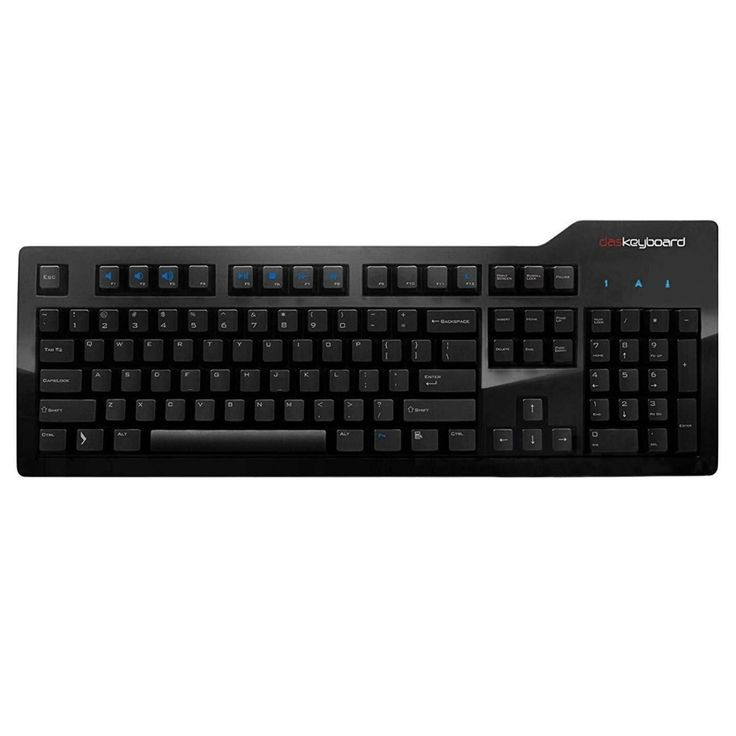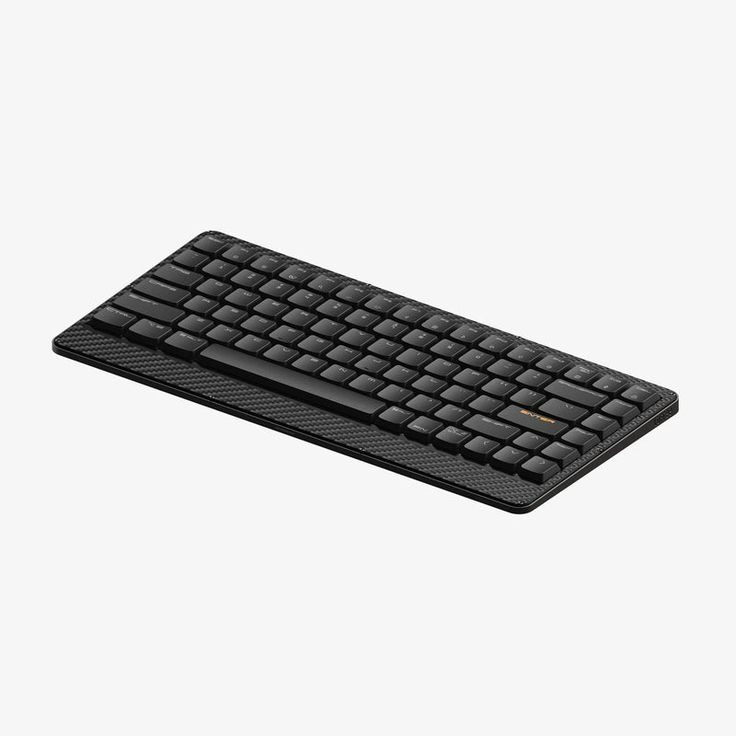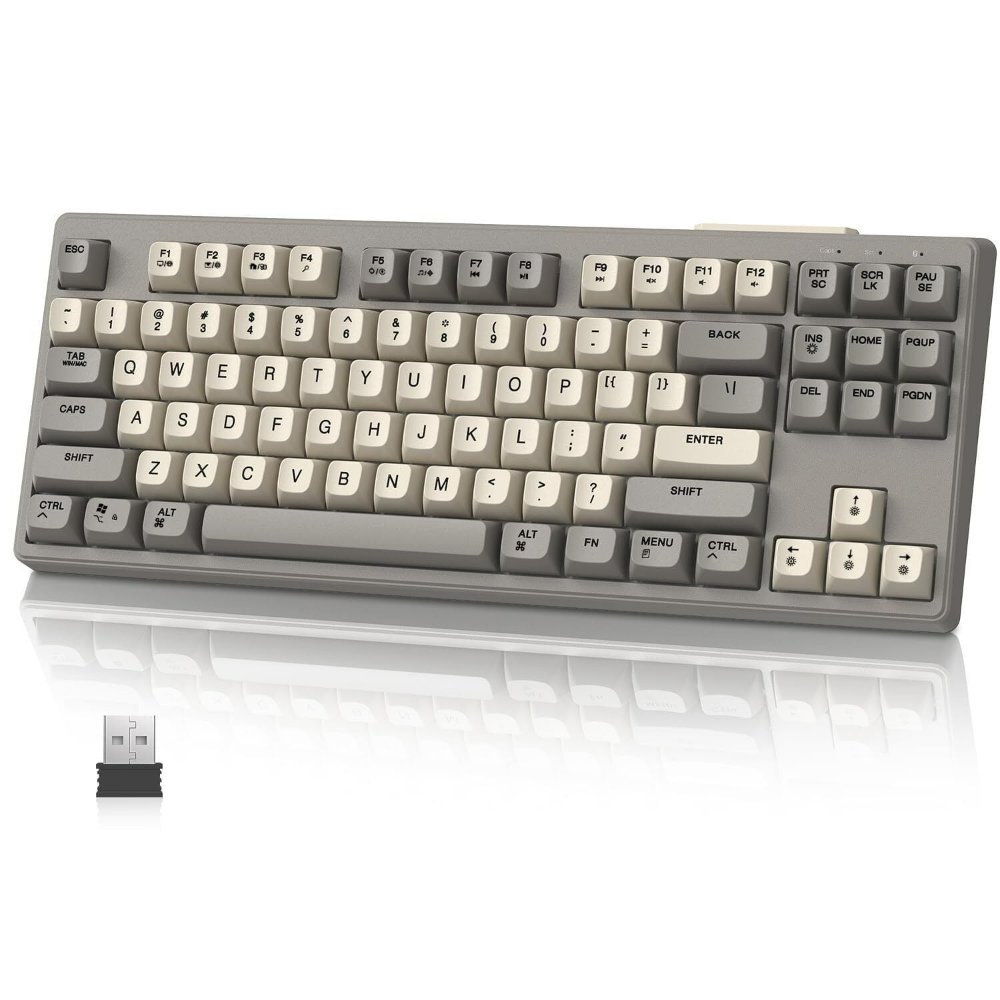What Are Mechanical Keyboards and How Do They Work?
A mechanical keyboard is a type of keyboard with individual switches under each key. When you press a key, the switch beneath is activated, registering a keystroke to your device. Unlike membrane keyboards, which use pressure pads, mechanical keyboards offer a tactile feel and audible click. Each switch contains several parts: the base, the spring, and the stem. Pressing the key pushes the stem down against the spring, closing an electrical circuit.
Here’s a simple breakdown of the process:
- Pressing the Key: You push down on a keycap.
- Activating the Switch: The stem within the switch moves, compressing the spring.
- Registering the Keystroke: The movement is converted to an electrical signal.
- Sending the Signal: The signal is sent to your computer, showing the character on your screen.
With a quiet mechanical keyboard, manufacturers modify the switch design. They add materials like rubber dampeners or quieter switches to soften the sound. This ensures a quieter typing experience while maintaining the tactile feedback loved by users. For those who spend hours typing or gaming, a quiet mechanical keyboard can be a game-changer.
Each quiet mechanical keyboard on the market has its own features. They come with different switch types, keycap materials, and design elements that affect both the sound and the feel of typing. Users can choose a keyboard that suits their preference for a silent but responsive typing experience.

The Evolution of Mechanical Keyboards: From Loud Clicks to Quiet Keys
Mechanical keyboards have come a long way since their early days. Initially, they were known for their loud clicks and tactile feedback. It was common for each keystroke to produce a noticeable click sound. This sound became a signature of mechanical keyboards, often associated with a satisfying feeling of typing. However, as office environments and shared spaces became more prevalent, the loud clicking sound started to be a distraction.
Technology has advanced, and keyboard manufacturers have taken note of the preferences for quieter workspaces. They have introduced a variety of quiet mechanical keyboards designed to minimize noise. These days, innovations in switch design have led to the development of keyboards that still provide tactile feedback but with much less noise. For example, some switches have been designed with in-built silencers that reduce the sound of the keystroke without sacrificing the mechanical keyboard feel.
Quiet mechanical keyboards have rapidly gained popularity among typists, gamers, and professionals who work in shared spaces. They offer the same benefits of traditional mechanical keyboards — durability and precision — but with the added advantage of not disturbing those around you. As more people look for ways to reduce distractions and create a more pleasant work environment, quiet mechanical keyboards are expected to become a staple for computer users around the world.
As we look towards the future, we can expect quiet mechanical keyboards to evolve even further. Manufacturers are relentlessly working on new materials and design innovations that reduce key noise even more efficiently. This evolution signifies not just a change in user preference, but also an adaption to the evolving needs of modern workspaces and home setups.
Top Quiet Mechanical Keyboards to Look Out for in 2025
As we approach 2025, the race is on for the top quiet mechanical keyboards. These modern marvels are being designed with cutting-edge technology to provide an unbeatable typing experience without the noise. Here’s what to expect from the upcoming quiet mechanical keyboard models:
- Advanced Sound Dampening: Expect keyboards with superior sound-absorbing materials that dramatically reduce typing noise.
- Innovative Switch Designs: Manufacturers are evolving switch mechanisms to offer the tactile feel you love, but whisper-quiet.
- Enhanced Durability: New models tout even longer lifespans, ensuring that your investment is sound for years to come.
- Customization Options: Look for keyboards with customizable key sounds, so you can personalize your typing experience to your exact preference.
- Smart Connectivity: The future is wireless and so are quiet mechanical keyboards, with Bluetooth and Wi-Fi options becoming standard.
- Energy Efficiency: Expect battery life that lasts longer, with some keyboards requiring less frequent charging or battery changes.
Market leaders and emerging brands alike are placing a strong emphasis on quietness without compromising on performance. Whether you are a gamer needing silent but responsive keys, a writer in search of a peaceful writing environment, or a professional in a crowded office, these upcoming quiet mechanical keyboards are designed to meet diverse needs. Keep an eye out for announcements from top manufacturers, and be ready to upgrade your typing experience with the sound of silence.

The Benefits of Using a Quiet Mechanical Keyboard
There are numerous advantages to choosing a quiet mechanical keyboard over traditional models. Here are the key benefits:
- Reduced Distractions: A quieter keyboard means less noise to disrupt you or those around. This is perfect for shared workspaces and open offices.
- Increased Concentration: Less noise allows for better focus on your tasks. You’re less likely to be distracted by the sound of your own typing.
- Professional Environment: Quiet keyboards are office-friendly. They help maintain a professional atmosphere where phone calls and conversations aren’t overpowered by loud typing.
- Comfort for Long Periods: Typing on a quiet mechanical keyboard is less fatiguing. You don’t contend with the constant clack of keys, which can become grating over time.
- Improved Sound Quality for Calls and Recordings: With a quiet keyboard, your microphone picks up less background noise during calls and recordings, ensuring clearer audio quality.
- Suitable for Different Settings: You can use these keyboards in various contexts, such as in libraries, co-working spaces, and at home, without causing a disturbance.
- Enhanced Aesthetics: Many quiet mechanical keyboards come with sleek designs. They can complement your workspace’s aesthetics while working silently.
- Personal Comfort: Some people simply prefer the feel of a quieter keyboard. It can make the typing experience more enjoyable and less intrusive.
All these benefits contribute to a more productive and pleasant computing experience. A quiet mechanical keyboard can thus be a significant and sound investment for anyone spending considerable time on a computer.
Key Features to Consider When Choosing a Quiet Mechanical Keyboard
When searching for a quiet mechanical keyboard, several factors come into play. Here are some aspects to check before making a purchase:
- Switch Type: Not all switches are the same. Look for those designed to be silent. Some popular quiet switches include Cherry MX Silent Red and Brown.
- Keycaps Material: The build of keycaps affects sound. Soft materials like PBT can decrease noise.
- Build Quality: A sturdy frame can reduce vibrations and thus noise. Check the build material.
- Sound Dampening Add-ons: Some keyboards have O-rings or padding to muffle sound.
- Backlighting: If you work in low light, opt for keyboards with adjustable LED lighting.
- Connectivity Options: Consider whether you prefer a wired connection or the flexibility of wireless.
- Extra Features: Programmable macros, detachable cables, and anti-ghosting are handy.
- Ergonomics: A comfortable design can prevent strain over long typing sessions.
- Aesthetics: You may want a keyboard that matches your workspace’s style.
- Price: Ensure that the keyboard’s benefits align with the cost. Higher price doesn’t always mean better quality.
These features not only impact the noise level but also the overall user experience. By evaluating these key points, you can find the ideal quiet mechanical keyboard that meets your needs for sound, function, and comfort.

Sound Dampening Technologies in Mechanical Keyboards
To make a quiet mechanical keyboard, state-of-the-art sound dampening tech is essential. There are several key technologies that help in reducing the noise made by keystrokes. Here’s a look at what goes into silencing mechanical keyboards:
- Rubber O-Rings: Small rings fit around the base of keycaps, cushioning the impact as keys bottom out. This reduces noise significantly.
- Padded Printed Circuit Boards (PCBs): PCBs with extra padding absorb sound from key presses, dampening the sound that travels through the board.
- Silenced Switch Design: Some switches come with built-in dampeners. They mute the sound when the switch actuates, offering quiet yet tactile feedback.
- Sound-Absorbing Foam: Foam layers inside the keyboard casing trap sound. This ensures a quieter typing experience.
- Damped Keycaps: Keycaps made of softer materials can minimize sound. Materials like PBT are known for their sound-dampening properties.
Manufacturers are continually improving these technologies to create the ultimate quiet mechanical keyboard. They balance the need for silence with the satisfying feel of mechanical switches. As the demand for quiet keyboards rises, so does the sophistication of sound dampening. Users who value a noise-free environment have much to gain from these advancements. These technologies ensure every keystroke is whisper-quiet, yet the performance is uncompromised.
The Impact of Quiet Mechanical Keyboards on Gaming and Typing
Quiet mechanical keyboards have changed the game for both gamers and typists. The reduced sound level means that users can focus more on their tasks without the distracting noise. For gamers, the benefits are twofold: they can play without disturbing others, and the quiet keys allow for late-night gaming sessions without causing a disturbance. Typists and professionals benefit from the quiet operation, as it enables a less disruptive and more focused work environment.
In gaming, the precision and tactile feedback of mechanical keyboards are vital. Quiet mechanical keyboards retain these qualities without the accompanying loud click noise. This allows gamers to maintain their competitive edge with stealthy and accurate keystrokes. These keyboards often come with customizable settings, enabling gamers to tweak their equipment for optimal performance.
For typists, a quiet mechanical keyboard can lead to a more enjoyable and comfortable typing experience. The sound of keys clacking can be distracting, especially in shared spaces. A quieter keyboard minimizes this disruption, thus supporting better concentration and productivity. The comforting sound level of a quiet mechanical keyboard can also reduce stress and create a more tranquil typing environment.
Popular among a wide range of users, quiet mechanical keyboards demonstrate that performance need not be loud. They are an excellent choice for shared spaces, night owls, or anyone who prefers a quieter typing solution. As the quiet mechanical keyboard trend continues to grow, we can expect future keyboards to become even more silent while enhancing user experience for both gamers and typists alike.
Future Trends in Mechanical Keyboard Development
The future of quiet mechanical keyboards is shaped by user needs and technological innovations. With an eye on 2025 and beyond, here are the anticipated trends in their development:
- Enhanced Noise Reduction Materials: Upcoming models are expected to feature even more effective materials for sound absorption. Innovations may include new types of rubber and foam that further quiet keystrokes.
- Improved Switch Technology: The quest for silence drives the creation of new switch types. These may actuate with less force, reducing both the sound and the tactile impact on fingers.
- Sustainable Designs: As sustainability becomes crucial, look for eco-friendly materials in keyboard construction. Keyboards may also offer longer lifespans to reduce electronic waste.
- Integration with Smart Homes: Keyboards may sync with other devices, allowing for smart home control directly from your keyboard.
- AI-Powered Features: Advanced quiet mechanical keyboards could come with AI that learns your typing habits to improve efficiency and comfort.
- Enhanced Customization: Expect a rise in keyboards with swappable switches, customizable key maps, and dynamic lighting options. Personalization will be key.
- Biometric Security: Future keyboards might include features like fingerprint sensors, adding an extra layer of security to your typing device.
- Focus on Health: Ergonomics will continue to be a focus. Expect designs that promote better posture and reduce the risk of repetitive strain injuries.
As the landscape of technology evolves, so too do mechanical keyboards. With these trends, quiet mechanical keyboards will not only adapt to the changing demands of users but will redefine the relationship between user and machine, making every keystroke a whisper in a world that values peace and productivity.